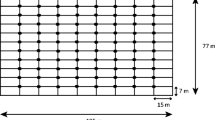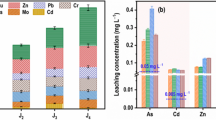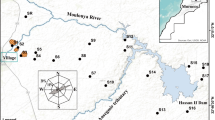Abstract
High amounts of tailings with a low recycling rate are generated during mining and smelting processes, and a lot of environmental problems were caused by heavy metal leaching from tailings. Temperature is a key point in heavy metals leaching, and knowing the effects of temperature on tailings leaching is useful for tailings management. A small-scale batch leaching experiment was conducted at different temperatures to test temperature-driven heavy metal leaching from tailings in the arctic area. The variation in the leaching of heavy metals from tailings was investigated by a small-scale batch leaching experiment. Results showed that 10 °C is a threshold temperature for the leaching activity of the tested elements. Fe, Cr, and Cu are significantly correlated with temperature in the leaching. Leaching rates of Cr, Cu, and Ni increase as temperature rises. Leaching rates of Cr, Cu, Ni, V, and Zn change by a polynomial model with temperatures, whereas that of Fe changes with a linear model. V shows an antagonistic relationship with Cu, Fe, and Ni in the leaching. However, Cu, Cr, Ni, and Fe show a synergistic relationship. Discovering the threshold temperature of leaching tailings in the arctic area and concluding the influence factors and the relationship between heavy metals leaching and temperature are useful for tailings management.






Similar content being viewed by others
References
Ahonen, L., & Tuovinen, O. H. (2010). Microbiological oxidation of ferrous iron at low temperatures. Applied and Environmental Microbiology, 55(2), 312–316.
Alghanmi, S. I., Al Sulami, A. F., et al. (2015). Acid leaching of heavy metals from contaminated soil collected from Jeddah, Saudi Arabia: kinetic and thermodynamics studies. International Soil and Water Conservation Research, 3(3), 196–208.
Anderson, B., Brown, A., Watt, W., & Marsalek, J. (1998). Biological leaching of trace metals from stormwater sediments: influential variables and continuous reactor operation. Water Science and Technology, 38(10), 73–81.
Azcue, J. M., & Nriagu, J. O. (1995). Impact of abandoned mine tailings on the arsenic concentrations in Moira Lake, Ontario. Journal of Geochemical Exploration, 52(1–2), 81–89.
Baba, A., Gurdal, G., Sengunalp, F., & Ozay, O. (2008). Effects of leachant temperature and pH on leachability of metals from fly ash. A case study: can thermal power plant, province of Canakkale, Turkey. Environmental Monitoring and Assessment, 139(1), 287–298.
Bai, Y., Collier, N., Milestone, N., & Yang, C. (2011). The potential for using slags activated with near neutral salts as immobilisation matrices for nuclear wastes containing reactive metals. Journal of Nuclear Materials, 413(3), 183–192.
Bin, C., Meilin, Z., et al. (2014). Study on the release and migration of heavy metals in tailings and their bioavailability. Environmental Science & Technology, 37(7), 12–19.
Blais, J., Tyagi, R., & Auclair, J. (1993). Bioleaching of metals from sewage sludge: effects of temperature. Water Research, 27(1), 111–120.
Cervantes-Ramírez, L. T., Ramírez-López, M., Mussali-Galante, P., Ortiz-Hernández, M. L., Sánchez-Salinas, E., & Tovar-Sánchez, E. (2018). Heavy metal biomagnification and genotoxic damage in two trophic levels exposed to mine tailings: a network theory approach. Revista Chilena de Historia Natural, 91(1), 6.
Cheng, X., Danek, T., Drozdova, J., Huang, Q., Qi, W., Zou, L., Yang, S., Zhao, X., & Xiang, Y. (2018). Soil heavy metal pollution and risk assessment associated with the Zn-Pb mining region in Yunnan, Southwest China. Environmental Monitoring and Assessment, 190(4), 194.
Daishe, W., Baoshan, Z., et al. (2004). Study on leaching behavior and environmental impact of coal gangue - a case study of Panxie Mining Area in Huainan. Earth and Environment, 32(1), 55–59.
Dold, B. (2014). Submarine tailings disposal (STD)—a review. Mineral-Basel, 4(3), 642–666.
Duo M (2007). Leaching characteristics and releasing amount evaluation of Mo tailing. Master dissertation, Liaoning Institute of Technology, available from Cnki.
Fan, L. Q., Zhou, X., et al. (2016). Release of heavy metals from the pyrite tailings of Huangjiagou pyrite mine: batch experiments. Sustainability, 8(1).
Fu, S. and Lu, J. M. (2018). Column leaching test on oxidized and non-oxidized tailings in northern Norway. IOP Conference Series: Earth and Environmental Science, 191.
Fu, S., & Wei, C. Y. (2013). Multivariate and spatial analysis of heavy metal sources and variations in a large old antimony mine, China. Journal of Soils and Sediments, 13(1), 106–116.
Guo, Y., Huang, P., et al. (2003). Leaching of heavy metals from Dexing copper mine tailings pond. T Nonferr Metal Soc, 23(10), 3068–3075 (2013).
Hu MH, Yuan JH, Lai CT (2014). Pollution loss rate assessment of soil heavy metals in paddy field with sewage irrigation in Guixi city, Jiangxi province, China. In: Wang L (ed) International conference machinery, electronics and control simulation Vol. 614, pp 658–663.
Igwe, O., Una, C. O., Abu, E., & Adepehin, E. J. (2017). Environmental risk assessment of lead-zinc mining: a case study of Adudu metallogenic province, middle Benue Trough, Nigeria. Environmental Monitoring and Assessment, 189(10), 492.
Islam, M. N., Jo, Y.-T., & Park, J.-H. (2012). Remediation of PAHs contaminated soil by extraction using subcritical water. Journal of Industrial and Engineering Chemistry, 18(5), 1689–1693.
Iversen, E., Berge, J. (2001). Nikkel og Olivin A/S Utredning av konsekvenser i forbindelse med nytt deponi på Fornes.
Jenkins, H., & Yakovleva, N. (2006). Corporate social responsibility in the mining industry: exploring trends in social and environmental disclosure. Journal of Cleaner Production, 14(3), 271–284.
Jing, L., Renkou, X., Xin, J., Yongrong, B., & Wenfeng, T. (1994). Adsorption and desorption of Cu(II), Pb(II) and Cd(II) in two variable charge soils different in pH. Soil, 39(6), 992–995 (2007).
Jingyong, L., Xiangyang, C., & Xianglin, T. (2006). Review of heavy metal pollution in mine development process. Mineral Resources and Geology, 06, 645–650.
Juve, G. (1967). Zinc and lead deposits in the Håfjell syncline, Ofoten, northern Norway. Universitetsforlaget.
Li Jyur, T., et al. (2003). Effect of temperature on removal of heavy metals from contaminated river sediments via bioleaching. Water Research, 37(10), 2449–2457.
Li, L. H., Fu, Q. L., Achal, V., & Liu, Y. L. (2015). A comparison of the potential health risk of aluminum and heavy metals in tea leaves and tea infusion of commercially available green tea in Jiangxi, China. Environmental Monitoring and Assessment, 187(5), 228. https://doi.org/10.1007/s10661-015-4445-2.
Liancun, G., Guihua, H., Suping, F., Shureng, W., & Zhaojie, C. (1994). Solubility and exchange of Cu, Pb, Zn, Cr species in simulant acid rain. Environment and Chemistry, 13(5), 448–452.
Liang, B., Jiang, L. G., et al. (2010). Analysis of influence factors on heavy metal release from mine waste rock in Fu Xin mine area. Applied Mechanics and Mechanical Engineering, 29–32(Pts 1-3. H. H. Tan), 2570–2575.
Lu, C. (2016). Study on speciation distribution and leaching characteristics of heavy metals in pb-Zn. Master dissertation, Xinjiang University, available from Cnki.
Newman, H. R. (2015). The mineral industry of Norway. Minerals yearbook, 2012, V. 3, Area Reports, International, Europe and Central Eurasia.
Ramirez-Llodra, E., Trannum, H. C., Evenset, A., Levin, L. A., Andersson, M., Finne, T. E., Hilario, A., Flem, B., Christensen, G., Schaanning, M., & Vanreusel, A. (2015). Submarine and deep-sea mine tailing placements: a review of current practices, environmental issues, natural analogs and knowledge gaps in Norway and internationally. Marine Pollution Bulletin, 97(1), 13–35.
Shaojian, M., Zhiliu, H., et al. (2002). Experimental study on dissolution of heavy metal ions in tailings of sulfide ore. Journal of Guangxi University: Natural Science Edition, 27(4), 273–275 L.
Shi, H.-S., & Kan, L.-L. (1989). Leaching behavior of heavy metals from municipal solid wastes incineration (MSWI) fly ash used in concrete. Journal of Hazardous Materials, 164(2), 750–754 (2009).
Simona, C., Angela, R. F., & de Santo Amalia, V. (2009). Suitability of soil microbial parameters as indicators of heavy metal pollution. Water, Air, and Soil Pollution, 158(1), 21–35 (2004).
Skjelkvåle, B. L., Steinnes, E. et al. (2006). Trace metals in Norwegian surface waters, soils, and lake sediments-relation to atmospheric deposition. Norwegian Institute for Water Research, pp. 10–21.
Tianhu, C., Xiaohui, F., & Xiaochun, X. (2001). Advances in acid drainage and heavy metal leaching in tailings abroad. Environmental Pollution Control Technology and Equipment (Chinese), 2(2), 41–46.
Tsai, L. J., Yu, K. C., Chen, S. F., & Kung, P. Y. (2003). Effect of temperature on removal of heavy metals from contaminated river sediments via bioleaching. Water Research, 37(10), 2449–2457. https://doi.org/10.1016/s0043-1354(02)00634-6.
Tyagi, R., Meunier, N., & Blais, J. (1996). Simultaneous sewage sludge digestion and metal leaching effect of temperature. Applied Microbiology and Biotechnology, 46(4), 422–431.
Wang, Q., Liu, Y. et al. (2015). Experimental study on the dynamic leaching effect of simulated acid rain on tailings of Dexing copper mine.
Wei, Z., Alakangas, L., et al. (2016). Geochemical evaluation of heavy metal migration in Pb–Zn tailings covered by different topsoils. Journal of Geochemical Exploration, 165, 134–142.
Wiertz, J., & Marinkovic, F. (2005). Dissolved pollutant transport in tailings ponds. Environmental Geology, 47(2), 237–240.
Wills, B. A., & Finch, J. (2015). Wills’ mineral processing technology: an introduction to the practical aspects of ore treatment and mineral recovery. Oxford: Butterworth-Heinemann.
Xianwei, W., Youning, X., Ming, Y., & Yanjun, Q. (2009). Review on risk assessment methods for soil heavy metal contamination in mines at home and abroad. China Mining Magazine, 18(10), 54–56.
Xiaojuan, S., Shulan, Z., & Lian, D. (2012). Leaching characteristics of MSW compost heavy metals in soil under different temperatures and simulated acid rain. Chinese Journal of Environmental Engineering, 6(3), 995–999.
Xiaolan, Z., et al. (2009). Effect of simulated acid rains on Cd form transformation in contaminated soil. Soils, 41(4), 566–571.
Yan, Q., Xiaochun, X., Qiaoqin, X., & Yubing, S. (2008). Leaching experiments of experimental pollution caused by heavy metals of waste rocks in the copper mine: a case study of Yaoyuanshan ore deposit in the Fenghuangshan Copper Ore Field, Anhui, China. Chinese Acta Geoscientica Sinica, 29(2), 247–252.
Ye, M., Yan, P., Sun, S., et al. (2017). Bioleaching combined brine leaching of heavy metals from lead-zinc mine tailings: Transformations during the leaching process. Chemosphere, 168, 1115–1125.
Yin, S. H., Wang, L. M., et al. (2018). Copper recycle from sulfide tailings using combined leaching of ammonia solution and alkaline bacteria. Journal of Cleaner Production, 189, 746–753.
Yuebing, S., Qixing, Z., & Guanlin, G. (2007). Phytoremediation and strengthening measures for soil contaminated by heavy metals. Chinese Journal of Environmental Engineering, 1(3), 103–110.
Zhang, G. Y., Lin, Y. Q., & Wang, M. K. (2011). Remediation of copper polluted red soils with clay materials. Journal of Environmental Sciences, 23(3), 461–467. https://doi.org/10.1016/s1001-0742(10)60431-7.
Zhang, L., Zhang, D. W., Wei, Y., Luo, L., & Dai, T. (2014). Risk assessment of trace elements in cultured freshwater fishes from Jiangxi province, China. Environmental Monitoring and Assessment, 186(4), 2185–2194. https://doi.org/10.1007/s10661-013-3528-1.
Funding
This study was financially supported by the MIN-NORTH project funded by Interreg Nord Program: Development, Evaluation and Optimization of Measures to Reduce the Impact on the Environment from Mining Activities in Northern Regions; China’s Post-doctoral Science Foundation (2017M612161), Jiangxi postdoctoral research project (2017KY05).
Author information
Authors and Affiliations
Contributions
Shuai Fu and Jinmei Lu: conception and design, acquisition of data, analysis and interpretation of data, drafting the article, and revised and approved the manuscript.
Corresponding author
Ethics declarations
Conflict of interest
The authors declare that they have no competing interests.
Additional information
Publisher’s note
Springer Nature remains neutral with regard to jurisdictional claims in published maps and institutional affiliations.
Rights and permissions
About this article
Cite this article
Fu, S., Lu, J. Temperature-driven variation in the removal of heavy metals from contaminated tailings leaching in northern Norway. Environ Monit Assess 191, 123 (2019). https://doi.org/10.1007/s10661-019-7244-3
Received:
Accepted:
Published:
DOI: https://doi.org/10.1007/s10661-019-7244-3




